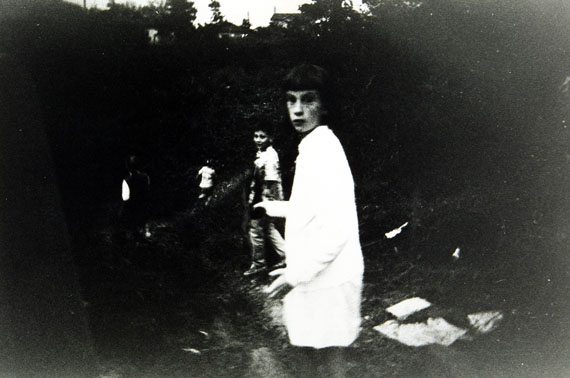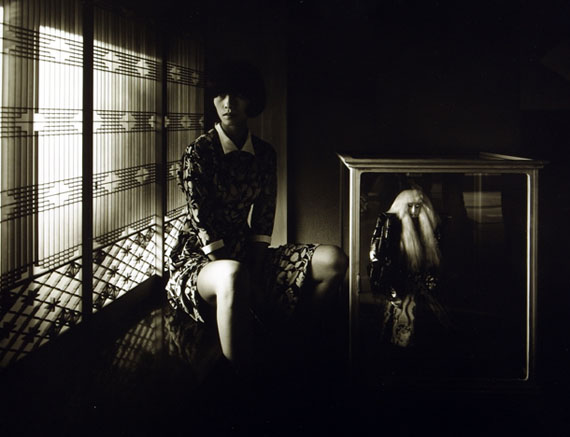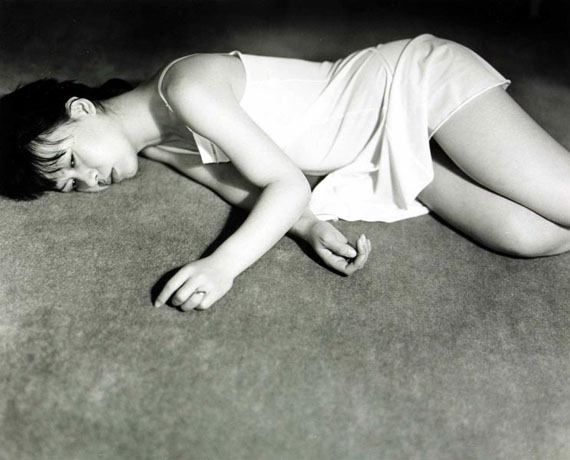
Yoko, my Love, undated
Gelatin silver print on Baryt (Vintage print)
© Nobuyoshi Araki
I-Photo
Japanese Photography 1960―1970 from the Collection / Japanische Fotografie 1960-1970 aus der Sammlung
Shunji Õkura » Nobuyoshi Araki » Masahisa Fukase » Takashi Hanabusa » Bishin Jumonji » Daidō Moriyama » Masaaki Nakagawa » Issei Suda » Akihide Tamura » Yoshihiro Tatsuki » Shin Yanagisawa »
Exhibition: 21 Apr – 8 Jul 2018
Fri 20 Apr 19:00

Museum der Moderne Rupertinum
Wiener-Philharmoniker-Gasse 9
5020 Salzburg
+43 662-842220
info@museumdermoderne.at
www.museumdermoderne.at
Tue-Sun 10-18, Wed 10-20
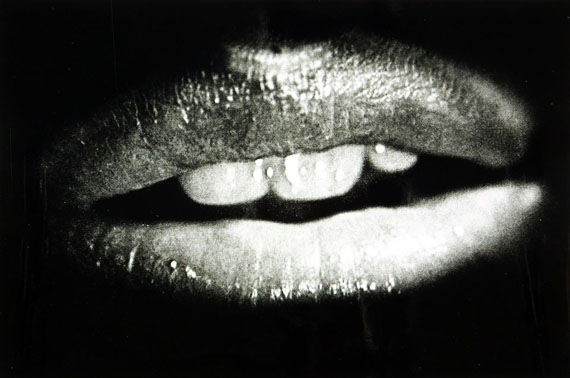
Lips from a Poster, 1975
Gelatin silver print on Baryt
© Daidō Moriyama
"I-Photo"
Japanese Photography 1960―1970 from the Collection
with works by Nobuyoshi Araki, Masahisa Fukase, Takashi Hanabusa, Bishin Jumonji, Daidõ Moriyama, Masaaki Nakagawa, Shunji Õkura, Issei Suda, Akihide Tamura, Shin Yanagisawa, Yoshihiro Tatsuki
Exhibition: 21 April ― 8 July, 2018
Opening: Friday, 20 April, 7pm
Diverse and controversial, sometimes mysterious and often at odds with stereotypical ideas about Japan: there is much to discover in Japanese photography from the 1960s and 1970s. The Museum der Moderne Salzburg now presents its extensive and singular collection in a two-part exhibition series.
For the first time in many years, the Museum der Moderne Salzburg puts its collection of ca. 600 original prints of Japanese photography from the 1960s and 1970s, which was purchased in the museum’s early years, on display. The series of two shows begins with "I-Photo. Japanese Photography 1960–1970" from the Collection, which presents works that focus on the depiction of the human being and the changes in postwar Japanese society. "In this exhibition, my vigorous efforts to undertake a thorough review of our collections are bearing fruit, and so I am especially pleased that we are able to present our holdings of Japanese photography—a sizable ensemble of outstanding works—which have not been seen by the public in a long time. The show also spotlights a chapter in the history of the museum, which started collecting and conserving photography early on. Otto Breicha, the museum’s first director, personally traveled to Japan to meet many of the artists and select works for the projected exhibition," Sabine Breitwieser, Director of the Museum der Moderne Salzburg, observes. Curator of Photography and Media Art Christiane Kuhlmann emphasizes that "this effort to champion Japanese culture and acquire Japanese art for the nascent collection constitutes a pioneering achievement." "At the time, the primary media in which Japanese photographers presented their pictures were photobooks and magazines," Kuhlmann notes, "so that vintage prints in the quality and form at our disposal are now hard or impossible to come by. Breicha’s initiative to build a center for contemporary photography in Austria was in part motivated by his experiences in Japan."
In the early 1960s, Japan enters a period of fast-paced economic growth, becoming a leading technology manufacturer. A quarter-century after the end of the war and the nuclear bombs over Hiroshima and Nagasaki, Japan hosts Expo’70, the first world’s fair to be held in an Asian country. Tokyo grows into an enormous megalopolis; construction on an international airport that will connect it to the entire world begins in 1971. These developments mark the definite end of the island nation’s decades-long isolation from the West, bringing rapid changes that affect Japanese society as well. In the 1960s, millions of Japanese citizens rally to protest against educational and land reforms and the security treaty with the former enemy, the United States of America. The Japanese photography scene devises a new and dynamic visual language that reflects the country’s more expansive self-image. Distinctive features include the reflection on perception, the quest for novel ways to express the self, and a revised definition of the photographic medium. Hard black-and-white contrasts and lacerated abstract structures are characteristic of the aesthetic of these pictures.
The idea of the "I-photo" is an adaptation of the term "I-novel," which designates a genre of first-person narrative fiction in Japanese literature. Conceiving of themselves as authors, the photographers understand the "I-photo" as the instrument of an exploration of reality. Japan’s photography scene is often highly controversial, with themes ranging from erotic depictions of bodies to political statements. Western observers are bound to find some pictures enigmatic and unsettling; they run counter to how Japan is generally imagined abroad. Yet it was Western art institutions that, in the 1970s, first included Japanese contemporary photography in their programming. Neue Fotografie aus Japan (New Photography from Japan) was the title of the first exhibition in Europe that Otto Breicha mounted in Graz in 1977; with I-Photo. Japanese Photography 1960–1970 from the Collection, the Museum der Moderne Salzburg brings back the exhibits from that historic show, though with different emphases. The presentation includes works by the photographers associated with the magazine Provoke (1968–1969) in which reality seems to be dismantled into its constituent elements, as well as by artists such as Nobuyoshi Araki and Masahisa Fukase who pursued their own highly individual creative agendas. Also on display are pictures by the members of the Kompora group, who sought to render a lucid and accurate portrait of everyday life in a clinical visual idiom.�
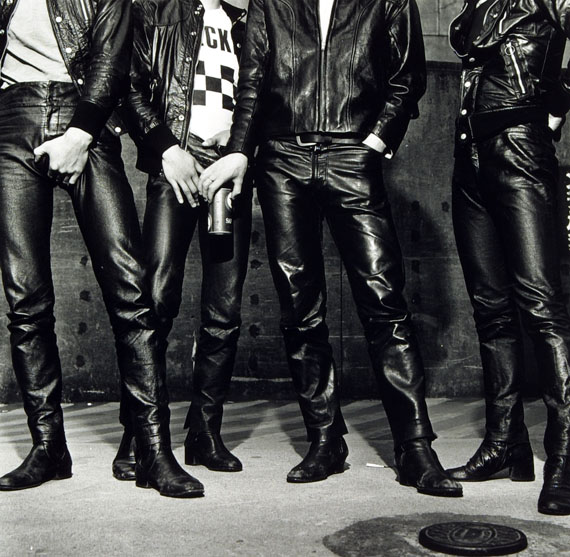
Untitled, 1971 Gelatin silver print on Baryt
© Bishin Jumonji
"I-Photo"
Japanische Fotografie 1960-1970 aus der Sammlung
mit Werken von Nobuyoshi Araki, Masahisa Fukase, Takashi Hanabusa, Bishin Jumonji, Daidõ Moriyama, Masaaki Nakagawa, Shunji Õkura, Issei Suda, Akihide Tamura, Shin Yanagisawa, Yoshihiro Tatsuki
Ausstellung: 21. April bis 8. Juli 2018
Eröffnung: Freitag, 20. April, 19 Uhr
Vielseitig und kontrovers, zuweilen rätselhaft und oft gängigen Japan-Vorstellungen entgegenlaufend, zeigt sich die japanische Fotografie der 1960er- und 1970er-Jahre. Das Museum der Moderne Salzburg präsentiert seine umfangreichen und einzigartigen Bestände nun in einer zweiteiligen Ausstellungsreihe.
Nach vielen Jahren macht das Museum der Moderne Salzburg sein Konvolut von rund 600 Originalabzügen japanischer Fotografie aus den 1960er- und 1970er-Jahren, das in den Anfangsjahren des Museums erworben wurde, erstmals wieder zugänglich. Den Auftakt einer zweiteiligen Ausstellungsreihe bildet "I-Photo". Japanische Fotografie 1960–1970 aus der Sammlung mit Werken, die sich der Darstellung des Menschen und der sich verändernden japanischen Gesellschaft der Nachkriegszeit widmen.
"Diese Ausstellung ist ein Ergebnis der von mir forcierten Aufarbeitung unserer Sammlungen. Es freut mich daher sehr, unsere gleichermaßen umfangreichen wie hochkarätigen Bestände an japanischer Fotografie nach langer Zeit wieder präsentieren zu können. Dabei richten wir unseren Blick auch auf die Geschichte des Museums, an dem bereits früh begonnen wurde, Fotografie auszustellen sowie zu sammeln und zu bewahren. Otto Breicha, erster Direktor des Museums, reiste dazu u. a. auch nach Japan, wo er viele der Künstler persönlich traf, um Werke für eine Ausstellung auszuwählen", so Sabine Breitwieser, Direktorin des Museum der Moderne Salzburg. Christiane Kuhlmann, Kuratorin Fotografie und Medienkunst, betont "die Pionierleistung, die durch das Engagement für den japanischen Kulturkreis in der Frühphase des Sammlungsaufbaus erfolgte". "Japanische Fotograf_innen präsentierten ihre Bilder damals hauptsächlich in Fotobüchern und Magazinen", so Kuhlmann, "weshalb Vintage-Abzüge in der uns zur Verfügung stehenden Qualität und Form heute selten bis gar nicht mehr erhältlich sind. Die Erfahrungen, die Breicha in Japan machte, waren einer seiner Beweggründe für den Aufbau eines Zentrums für zeitgenössische Fotografie in Österreich."
Ab Beginn der 1960er-Jahre erlebt Japan ein starkes Wirtschaftswachstum und steigt zu einem der führenden Technologieproduzenten auf. Ein Vierteljahrhundert nach Kriegsende und den Atombombenabwürfen auf Hiroshima und Nagasaki ist Japan mit der Expo’70 erster asiatischer Gastgeber einer Weltausstellung. Tokyo wächst zu einer gigantischen Stadt an und ist durch den Bau des internationalen Flughafens 1971 aus der ganzen Welt erreichbar. All dies beendet die jahrzehntelange Abschottung des Landes vom Westen. Der damit einhergehende rasante Wandel betrifft auch die japanische Gesellschaft. Auf die Bildungs- und Agrarreformen in den1960er-Jahren sowie auf das Sicherheitsabkommen mit dem ehemaligen Aggressor, den Vereinigten Staaten von Amerika, reagieren Millionen von Japaner_innen mit Protesten. Das erweiterte Selbstverständnis des Landes findet durch eine neue dynamische Bildsprache Widerhall in der japanischen Fotoszene. Bezeichnend dafür sind die Reflexion der Wahrnehmung, die Suche nach neuen Ausdrucksformen des Selbst und die Neudefinition des Mediums Fotografie. Harte Schwarz-Weiß-Kontraste und aufgerissene, abstrakte Strukturen kennzeichnen dabei die Ästhetik der Bilder.
Der Begriff des "I-Photo", also des "Ich-Fotos", lehnt sich an das literarische Genre der Ich-Erzählung an. Die Fotograf_innen, die sich als Autor_innen verstehen, fassen das "I-Photo" als Mittel der Erforschung von Realität auf. Dabei ist die Fotoszene Japans höchst kontrovers und das thematische Spektrum reicht von erotischen Köperbildern bis hin zu politischen Statements. Für westliche Betrachter_innen wirken die Bilder zuweilen rätselhaft und verstörend, widersprechen sie doch der allgemeinen Vorstellung von Japan. Dennoch waren es zuerst westliche Institutionen, die bereits in den 1970er-Jahren japanische Gegenwartsfotografie in ihr Programm aufnahmen. Unter dem Titel Neue Fotografie aus Japan organisierte Otto Breicha 1977 in Graz die erste europäische Ausstellung, deren damalige Exponate nun vom Museum der Moderne Salzburg in I-Photo. Japanische Fotografie 1960–1970 aus der Sammlung unter neuen Gesichtspunkten präsentiert werden. Neben den Fotografen um das Magazin Provoke (1968–1969), die in ihren Bildern die Wirklichkeit scheinbar in Einzelteile zerlegen, und den im Gegensatz dazu singuläre Positionen verfolgenden Künstlern Nobuyoshi Araki und Masahisa Fukase sind in der Ausstellung auch die Arbeiten der Gruppe Kompora zu sehen. Ihr Ziel war es, alltägliches Leben in distanzierter Bildsprache klar und genau widerzuspiegeln.�
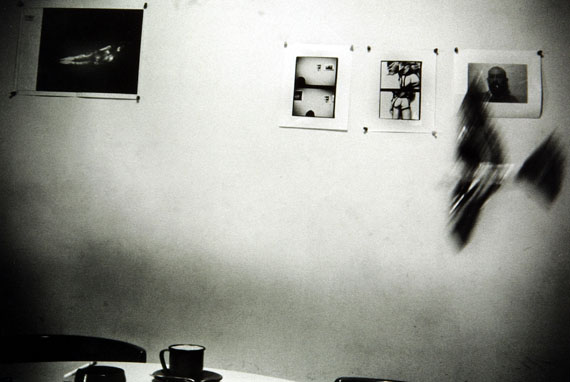
Selfportait, Against Wall of My Home, undated
Gelatin silver print on Baryt
© Masaaki Nakagawa
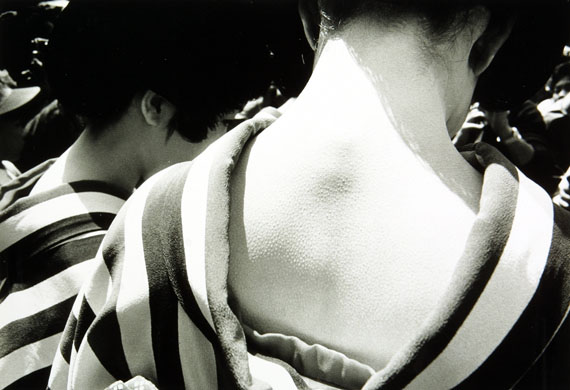
untitled, undated
Gelatin silver print on Baryt
© Takashi Hanabusa
